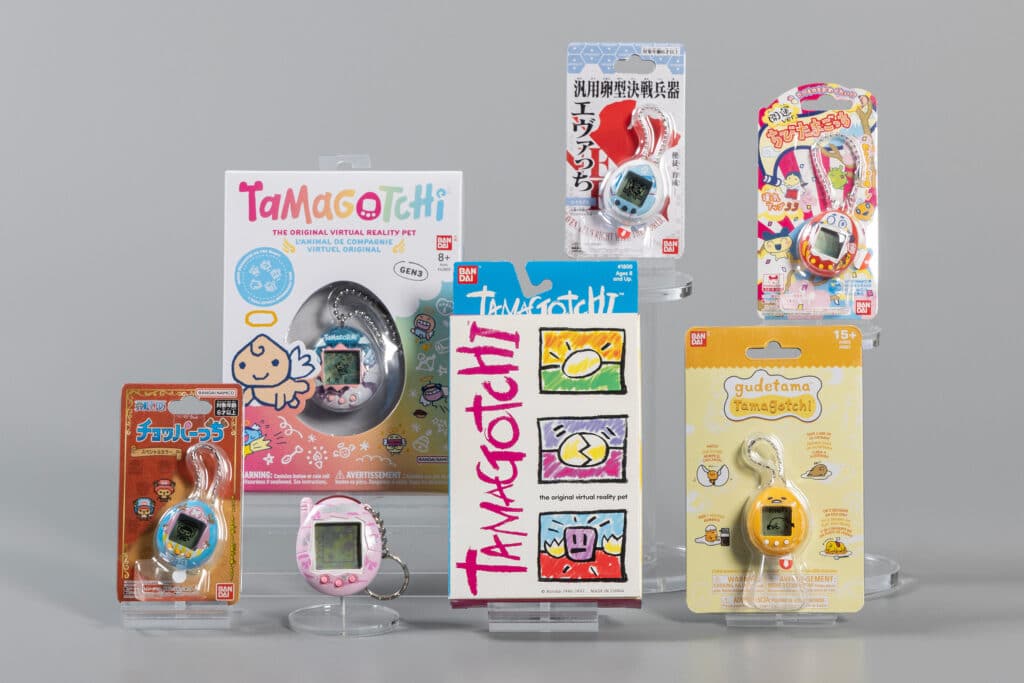Inducted: 2025
Considered a popular gaming fad of the 1990s, the handheld game Tamagotchi began with two fanciful childhood wishes: having a toy come alive and bringing a pet wherever you go. In 1995, former president of Wiz Company Akhiro Yokoi pitched the idea of a mobile pet toy to Japanese toy maker Bandai. The developer Aki Maita conceptualized Bandai’s raising simulator design for the electronic toy, influencing the future development of the virtual pet market in both video games and toys. Although initially conceived as a wristwatch, prohibitive manufacturing costs inspired Tamagotchi’s iconic egg-shape, meant to resemble a pocket watch. The unique name is a combination of the tamago (たまご), the Japanese word for “egg,” and uotchi (ウオッチ), a phonetic rendering of the English pronunciation for watch.

First released in Japan in 1996, Tamagotchi’s minimalistic design—three input buttons and a small non-backlit LCD screen—contrasted with the complex life cycle of the cyber creature. Navigating the virtual pet simulator, budding caretakers had to safely care for their pets from egg-hatching to adulthood, around 12 calendar days on average. This was anything but simple. To maintain optimal health and growth for the cyber-pets, children were perpetually “on call” to monitor snack time, meal time, play time, bathroom visits, time-outs, general attention, medicine and care, and nap time (don’t forget to turn off the lights!). Neglecting any of these—and the Tamagotchi’s “Beep! Beep! Beep!” warning sound—could result in sickness and death for the poor pet. As an added challenge for early users, a Tamagotchi’s lifecycle could not be paused, leading the game to be banned in school classrooms because it distracted its student caretakers.
Although Tamagotchi is often dismissed as a short-lived fad, the toy had quite a far-reaching impact beyond the mid-90s. Within its first year, about 20 million units of the toy were sold in Japan alone and another 20 million in other markets around the world, inspiring countless copycat versions. The game’s creators received the satirical Ig Nobel Prize in Economics, awarded by the Annals of Improbable Research humor magazine for a clever and amusing achievement that prompts curious thinking. In addition to a 1997 board game, Tamagotchi brand created versions of the game for the PC computer, SNES, Sony PlayStation, Sega Saturn, Nintendo Gameboy, Nintendo DS, and even mobile app versions for iOS and Android in the 2010s. Numerous animated films and Japanese anime offshoots extended the toy’s story world.
Tapping into generational nostalgia, Tamagotchi was rebooted in 2017 and 2020 with new elements, including a virtual library, virtual dressmakers, and the ability to marry pets to one another. The latest generation, Tamagotchi Uni, fulfilled the original dream of a wristwatch-style game and boasts Wi-Fi connectivity and a virtual space, Tamaverse. Bandai also continues to release revivals of old versions of the game and crossover products featuring pop culture icons like Eevee, Pac-Man, and Hello Kitty in place of or alongside the Tamagotchi characters. Per 2020 interviews by company representatives, around 40% of the game’s consumers are adults, bridging a divide between child and adult play.Beyond cultivating nostalgia, Tamagotchi offered a distinct form of play apart from the prevailing popularity of video game electronics at the time. In the book Millennial Monsters: Japanese Toys and the Global Imagination (2006), scholarAnne Allison argued that Tamagotchi provided young users with feelings of connection, intimacy, and personalization, a respite from competition and fighting games. Some children all over the world actually held funerals for their departed Tamagotchi pets, creating a space for tougher conversations on death and saying goodbye. The popularity of the pet simulation genre of video games was spurred by Tamagotchi, yielding popular games like Neopets, Nintendogs, and a plethora of social media and app-based games. And for the toy market, Tamagotchi helped influence the creation for other electronic pet care toys such as Furby and Sony’s AIBO robot dog.
Did You Know?
In 1997, schools in China, Hong Kong, Thailand, and the United States banned Tamagotchi for distracting students.




